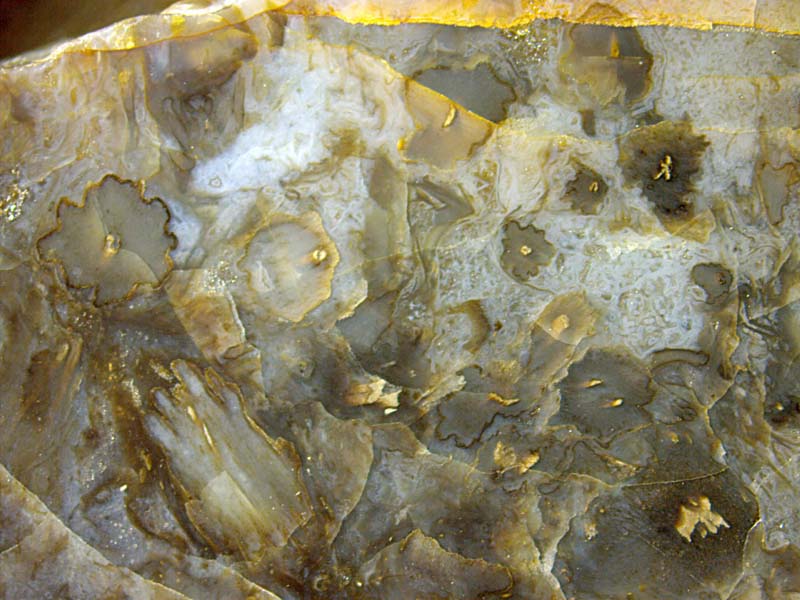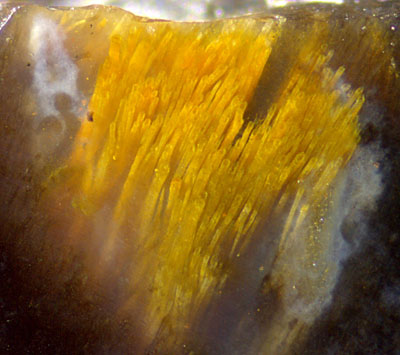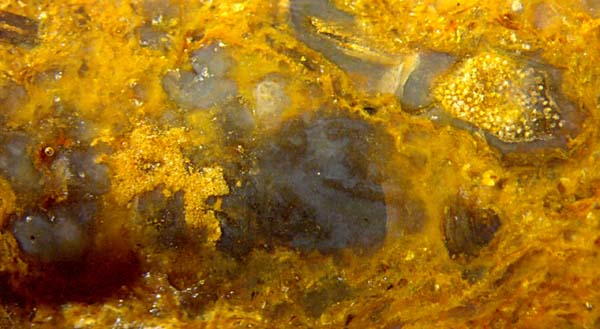Asteroxylon
aspects
Asteroxylon
is the most complex plant in the Lower Devonian Rhynie chert. It has
been described thoroughly before [1,2].
Nevertheless, some additional information may be useful. First, the
xylem strands can appear white instead of the usual black, which
is not an essential
feature but merely a detail of preservation. Second, the plant does not
always look like a recent clubmoss as much as current
reproductions [3] try to make believe.
What makes it look like a
clubmoss is the small leaf-like appendages called enations. As another
peculiar detail, the xylem strand is of a highly complex build. Its
cross-section is surprisingly variable [1], and it splits off thin
branches which sharply bend radially outwards, then upwards again, and
end within the stem in a patch of "transfusion tissue" [2].
According to own finds but contrary to the drawing in [3], the main
upright axis of Asteroxylon
does not seem to
branch profusely, although smaller aerial axes usually called branches
are often seen among the Asteroxylon
main axes in larger numbers (Fig.1). This suggests that they
possibly emerge immediately from an extended rhizome. Incidentally
these "branches" resemble the aerial
axes of Nothia,
which has made them a source of continuing confusion, all the more so
since the two plants may be found in the same piece of chert. (Nothia may be
recognized by tube-like "giant cells" running along the epidermis.)
Fig.1: Asteroxylon,
cross-sections of aerial axes on a cut chert face, xylem bleached after silicification. Width of the
picture 17mm.

Normally the xylem strands
appear black in the chert but not seldom they
are white when on the
surface of the sample. Hence, the white aspect must be the result of
some bleaching process penetrating for a small distance. The present
sample is different as the xylem strands are bleached
throughout. (Figs.1,2 show cut chert faces.)
There is a possible explanation of the selective
through-bleaching: Xylem strands in the chert have been
observed which easily soak up liquid, which means they still consist of
bundles of tubes, which makes easy diffusion paths. The bleaching by
diffusion of oxygen could have occurred while the strands were still in
such
state. By continuing deposition of silica the bleached strands became
compact chert as they are now
in the present sample.
Fig.2: Asteroxylon,
two sections of yellowish
xylem strands. (Same scale as Fig.1, for enlarged detail see Fig.3.)

Fig.3: Asteroxylon
tracheids seen as separate tubes on an inclined section of yellow
xylem in transparent chalzedony.
Detail of Fig.2, width 2.3mm.
Note that bleaching during and after silicification can affect the
visibility of fossil structures. Black tracheids would not stand out
against the dark background as the yellow ones do in Fig3.
While the xylem strands of Asteroxylon
are nearly always clearly seen, also in the usual state of preservation
where they had not passed a stage of bleaching, the tissue of the
aerial axes is nearly
always not seen or in a poor state of
preservation not suitable for reproduction.

Fig.4: Asteroxylon
on
the raw surface of the chert sample: cross-section of xylem within
decayed stem, sporangium with spores nearby. Width of the image 5.5mm.
The usual aspect of Asteroxylon
with well-preserved xylem but decayed other tissue is seen here
combined with a sporangium cut such that it seems to consist of two
compartments, one filled with yellow spores, the other one empty
and collapsed. (A similar example is seen in
[3].) As shown by Bhutta
[2] the sporangium can be shaped such that certain cut planes
produce the illusion of two chambers.
Another dubious sporangium is reported in Rhynie
Chert News 53. Asteroxylon may be
more variable than previously thought [4]. It has even been suggested
that there may be more than one Asteroxylon
species in the Rhynie chert [5].
H.-J. Weiss
2016 2018
[1]
R.
Kidston, W.H. Lang: On Old Red Sandstone plants showing
structure, Part III. Trans. Roy. Soc. Edinburgh 52(1920),
643-680.
[2] A.A. Bhutta:
Studies on the Flora of the Rhynie chert. Ph.D. thesis, University of
Wales, Cardiff, 1969.
[3] www.abdn.ac.uk/rhynie
[4] D.
Edwards: Embryophytic
sporophytes in the Rhynie and Windyfield cherts. Trans.
Roy. Soc. Edinburgh Earth Sci. 94(2004 for 2003), 397-410.
[5] W.
Remy, H.
Hass:
Langiophyton mackiei, ... . (Addendum p103). Argumenta
Palaeobot. 8(1991), 69-117.
 |
 |
94 |







